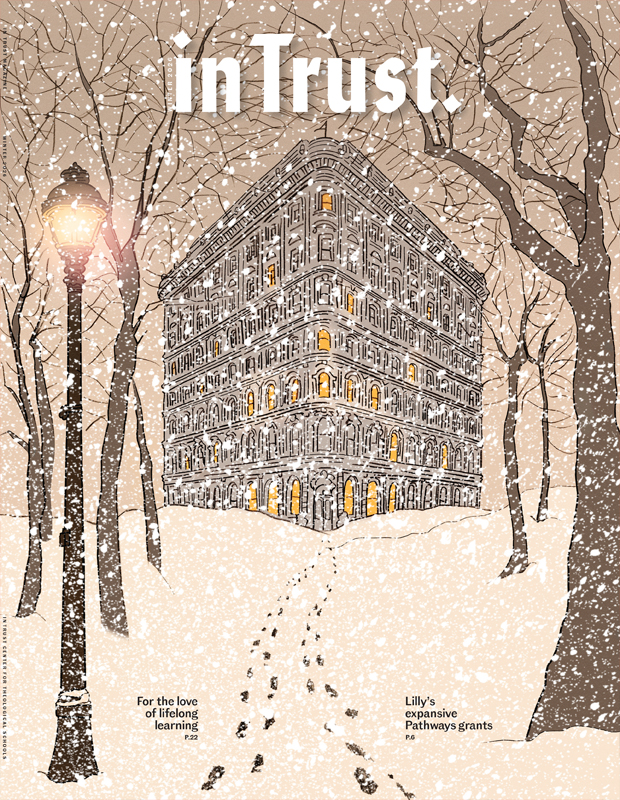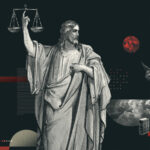Lilly Endowment technology grants to thirty theological schools–amounting to $210,000 each–are siring startling changes in the recipients’ lives. Some changes were expected, some were not. Some schools are looking ahead to major capital campaigns; two schools have committed themselves to a single shared computer hardware and software system; and three schools whose students are mostly commuters have found a technology-based tool that may revive lost community.
Listen to New Brunswick Theological Seminary’s Renee House on that last development: “The grant’s greatest benefit for us is that it allows for the redevelopment of a learning community through e-mail, an ongoing, engaged learning community that can relate beyond the walls of the classroom, beyond space and time. How will we be changed by finding substitute ways to be together?”
House, who directs New Brunswick’s Information Technology for Theological Teaching Project, was referring to the school’s decision to spend part of its Lilly money to provide e-mail accounts for all its students, most of whom are commuters. With e-mail, students can now have the conversation with each other and with teachers that used to be possible only on residential campuses. Without campus residence, it is hard “to keep continuity and collaboration” among students, said Cathy Dawson of Louisville Presbyterian Theological Seminary, another school with many commuting students. (Louisville Presbyterian, one-half to two-thirds of whose students are nonresident, is testing the impact of student e-mail before opening it to all, Dawson said.)
New Brunswick, Memphis Theological Seminary, and Interdenominational Theological Center (ITC) are the Lilly grantees that have chosen to make e-mail accessible to all their students, most of whom are commuters. Many of the students are already pastoring or are employed full-time; academic activity is an add-on to their family, parish, and other job responsibilities.
Memphis, for example, draws students–one-third of them African American–from a 200-mile radius scattered across Alabama, Mississippi, and Arkansas. Classes are set in three-hour blocks on specific weekdays or Saturdays so that commuters need to come to campus only once a week. At ITC, a historically black school in Atlanta, only a quarter of the students live on campus, and a fifth live entirely outside metropolitan Atlanta. ITC too has students who go to school at night and on Saturdays and miss much campus interaction.
New Brunswick has an offsite campus on St. John’s, in Jamaica, New York, as well as day and evening programs; the student body is 50 percent African American and 20 percent Korean. By becoming a commuter campus, the school’s enrollment went from 45 students in 1983 to 220 now–welcoming in especially women and minorities, who had been underserved in the past. E-mail communication, said House, “may make possible new kinds of connection that we have lost.”
How It All Began
In February 1997 the Lilly Endowment announced it would give away $6.8 million to fund information technology for theological teaching. Thirty schools of different sizes, missions, and levels of technology (see table at the end of this article) were awarded $10,000 each to plan what they would do with the $200,000 grant they were to receive at the end of the year. School representatives met as a group in Indianapolis to share ideas and concerns and, later in the year, met again in five clusters to discuss the direction their plans were taking. Lilly gave $500,000 to the Wabash Center for Teaching and Learning at Wabash College in Crawfordsville, Indiana, to help plan and implement the program.
“These grants and the opportunities to engage in a common conversation will help theological schools catch up with the curve and make the best and most effective use of technology,” predicted Raymond B. Williams, professor of religion and director of the Wabash Center. Grant planners hoped the experience of the thirty schools would be instructive to other theological schools. A collaborative approach was central to the grant, not only in each school but among the different schools themselves. Conversations among the schools were fostered by dividing them into six-member groups that were not necessarily geographical in nature.
Williams’s prediction came true and then some. Probably all project directors would agree with their colleague Ralph Klein of Lutheran School of Theology at Chicago, who said, “It is one of these things that has unexpected consequences.”
While all the schools drew faculty members, librarians, media specialists, and administrators into their planning, Klein at LSTC and Kurt Gabbard at McCormick Theological Seminary took collaboration a step further. Neighbors in Chicago’s southside Hyde Park area, they have found that the grants are leading them down an unexpected cooperative path. The two schools already shared some resources–classrooms and the library, and occasionally team teaching–and LSTC made limited use of McCormick’s language resource center on a fee-for-service basis. When Klein and Gabbard met in Indianapolis for discussion of the initial planning grants, they decided to pool their new technology resources and plan their grants together (thereby having the benefit of $20,000 for planning and, later, $400,000 for implementation). The schools never had separate committee meetings but did all their planning jointly; Gabbard and Klein demonstrated it by making a joint presentation of the final grant request at their cluster meeting.
As a result, the two schools are much closer and have a higher degree of cooperation in other areas. They have expanded the language resource center and moved it into LSTC’s main building (previously it had been on the fourth floor of a local church), combined their media centers, and focused the grant on creating five to six “smart,” state-of-the-art classrooms equipped with presentation software and directly connected to the Internet. All faculty will receive their choice of state-of-the-art desktop computer or laptop computer that can be plugged into an outlet in a smart classroom and from there into a projector. Over the three-year period of the grant, faculty will be trained together in groups of ten to use multimedia techniques and to help students convert material into digital formats that can in turn be projected on a screen. Technical support will also be shared.
“The challenge,” said Gabbard, “is how to combine support staffs of two institutions? Who would be accountable to whom?” The most immediate shared group would be the technical staff but, added Klein, “It is not beyond the realm of possibility to move forward to shared accounting and shared faculty responsibilities.”
Most exciting to him is that this has re-raised long-range strategic planning at LSTC–“we hadn’t taken full advantage of our proximity to McCormick and goodwill.” There are ecclesial issues as well, said Klein, that they have not addressed so far. Now that there is full communion between the Lutherans and Presbyterians (see In Trust, Autumn 1997, p. 26), it brings new responsibilities, and the schools are discussing a course on Luther and Calvin in dialogue. Both institutions have presidents who are relatively new, Klein pointed out, and both have taken to the collaborative approach. LSTC’s president James Kenneth Echhols keeps McCormick’s president, Cynthia Campbell, fully informed of the LSTC’s revived long-range planning process.
The model the schools are drawn to is that of their shared JKM Library. (Jesuit, Krauss, and McCormick are the three libraries that established the JKM Trust in 1995, a separate legal entity that has its own board of trustees, bank account, and budget.) They are also considering incorporating some collaborative activities into the JKM structure itself. The Lilly grant will not “save” either institution money, said Gabbard, but if “we can achieve efficiencies, especially on support staff, we can provide the kinds of services to faculty and students that they will expect of us as top-flight theological schools. Both have a very strong desire to be outstanding institutions.”
How To Start?
While none of the other thirty grantees moved so radically as McCormick and LSTC, implementation strategies varied widely among those interviewed (those with an asterisk in groups 2, 3, and 4). Some have focused on creating smart classrooms (classrooms that are wired and where fixed or portable computers, projectors, sound systems, CD-ROM can be plugged in), and on purchasing scanners, computers (often laptops for faculty); others have moved differently. According to Fuller project director Russell Spittler, Fuller Theological Seminary’s School of Theology, in Pasadena, California, started with the faculty. A third to one-half of the grant is going to seven faculty members, each of whom will fully integrate technology into the teaching of one specific course. Grant funds will be used for the hardware and software they need, for training and backup and to reduce their course load by half for one term so that they have extra development time. Proposals were chosen from among the twenty that were submitted after all eighty members of the combined Fuller faculty were invited to participate. Among the chosen courses are: Hebrew Exegesis; Homiletics and Systematic Theology; Medieval and Reformation History; Family Life Education; Shame and Psychotherapy; New Testament Greek; and Adult Training in the Info-Tech Age.
Toward the end of the grant period, each of the seven faculty will present a twenty-minute class segment to the whole Fuller faculty, and spend an equal amount of time discussing what worked and what didn’t.
Grant funds are also being used to equip several classrooms so that the faculty projects can be presented in them. This is a step in Fuller’s building, in phases, a centralized media access system for all of its classrooms.
While other institutions have taken a different approach from Fuller’s, faculty members at all schools interviewed have preferred time to money for special course-development efforts.
Intrinsic to technological teaching innovations is research on how adults learn. Gordon-Conwell Theological Seminary, according to its project director Wayne Goodwin, considers a research orientation on this subject essential. How do people, especially theological students, learn? What are the effects of age, geography, and other factors? The school has hired a staff member to conduct this research and report the results at the fall faculty retreat.
With this learning theory to bolster them, fifteen faculty members who have been given laptop computers will be trained to use technology that is integrated with course design.
Gordon-Conwell requires students to study Hebrew and Greek. The grant enables the school to continue to experiment with the teaching of these languages, using audio, video, CD-ROM, computer-assisted learning–in all, forty three-hour tutorials over a year. These students don’t necessarily come to class, and so far they have been enthusiastic about this self-paced learning. It is less daunting, especially for students in their forties and fifties, than traditional methods of instruction.
Most of the institutions interviewed were creating, or had already created, at least one classroom where audio and video equipment can be used as well as presentation software and where a direct connection to the Internet can be made. Some, like Louisville Presbyterian, are testing one set of mobile equipment before moving ahead; others, like Memphis and ITC, are permanently equipping at least one classroom and installing hookups for portable equipment in others. Some schools were already wired with fiber-optic cable (or had made a commitment to do so): among them are Princeton Theological Seminary, ITC, New Brunswick, and Union Theological Seminary in Virginia. At others, fiber-optic wiring was part of the grant.
Meeting Training Needs
Lilly stressed the need for a training component in the grants, and all the schools have made some provision, especially as faculty are in different places technologically. At one end of the training structure spectrum is Washington Theological Union, which will provide special instruction on an individual basis as the need arises. WTU has bought twenty machines that provide complete access to library resources, and project director John Hanson believes that people learn best when they have a specific task to accomplish. Group learning opportunities will also be offered when necessary.
Memphis will hire a part-time person to train faculty on the use of various technologies, including presentation technology. Union in Virginia is spending a quarter of its grant on training for staff and faculty, and will hire a coordinator of information technology for three years to link technology specialists and faculty. Fuller is establishing an Academic Technology Center to give ongoing support to the initial faculty projects as well as to assist in new faculty projects and provide general technological support for faculty research and teaching. Louisville Presbyterian is hiring an academic, curriculum, and computer support librarian, and McCormick and LSTC will train all their faculty together in groups of ten. Librarians at the JKM library are being trained to train faculty in presentation software.
Princeton’s training plan has a turnabout element to it, for students will contribute substantially to instruction for faculty and other students. According to project director James Armstrong, who is Princeton’s dean, this makes good sense, as students, the ultimate recipients of this technology, will provide a perspective that can be built into instruction. Since more than half of Princeton’s students are recent college graduates, they frequently have advanced computer know-how that faculty are pleased to tap into.
Theological Implications
Memphis, ITC, and New Brunswick, the schools that have opted for full e-mail availability for students, and Louisville Presbyterian, which may join them, are now waiting to see the full impact of their decision. Soon, they expect, professors will routinely circulate their syllabi by e-mail, and will create and lead e-mail discussion groups.
ITC’s David Rensberger believes that once faculty see what can be done with software, they will post not only syllabi but graphics and additional resource materials. The technology, he said, “will prove to have unseen benefits, opening up a whole new way of communicating, not only between faculty and students, but among students themselves.” House, at New Brunswick, expects that students will be assigned to regular online discussion groups as part of their course work. She commented that students need “integration time” to discuss questions: “Good teaching ought to evoke more questions.” Students will again be able to have “the ongoing discussion that used to occur when everyone lived here.”
House compares the effect of new technology to that of the printing press and the Gutenberg Bible. Back then, people thought those innovations would destroy learning communities–people could now read on their own and draw their own conclusions. The same sort of thing has been said about communications technology. “The struggle is that we are an incarnational bunch of people–Jesus was flesh and blood–and we don’t know entirely what to think of disembodied engagement,” House said.
Rensberger noted that congregations will never sing their hymns by e-mail. “Religion involves human connection–it requires the whole person to be there. Seminary education that did not involve actual sitting down together would be a loss.” The effect of technology should be to enhance the learning experience.
House says she’s not worried. We are not likely ever to do without excitement such as Adam’s when he discovered that Eve was “bone of my bones, and flesh of my flesh.”
Asked House: “Can we walk down the road of finding substitute ways to be together, embrace it, and at the same time keep a healthy skepticism?”
Information Technology for Theological Teaching — Grantees
| Group | Project Director | School | E-mail address |
| 1 | David Sebastian | Anderson University School of Theology | dlsebas@anderson.edu |
| 1 | Willard Swartley | Associated Mennonite Biblical Seminary | wswartley@ambs.edu |
| 5 | Thomas Johnson | Bethel Theological Seminary | thomasj779@aol.com |
| 5 | Gary Bekker | Calvin Theological Seminary | gbekker@calvin.edu |
| 1 | David Bundy | Christian Theological Seminary | dbundy@cts.edu |
| 4 | Jerry Garber | Claremont School of Theology | jgarber@cst.edu |
| 1 | Marge Gruber | Concordia Theological Seminary, Ft. Wayne | (not available) |
| 1 | Christine Larson | Earlham School of Theology/ Bethany Theological Seminary | larsoch@earlham.edu |
| 4 | Russell Spittler | *Fuller Theological Seminary | spittler@fuller.edu |
| 4 | Adolf Hansen | Garrett-Evangelical Theological Seminary | ahansen@nwu.edu |
| 4 | Jack Seymour | Garrett-Evangelical Theological Seminary | jse247@nwu.edu |
| 3 | Wayne Goodwin | *Gordon-Conwell Theological Seminary | weg83@bellsouth.net |
| 3 | David Rensberger | *Interdenominational Theological Center | drensberger@itc.edu |
| 2 | Cathy Dawson | *Louisville Presbyterian Theological Seminary | cathdawson@aol.com |
| 5 | Thomas Walker | Luther Seminary | twalker@luthersem.edu |
| 4 | Ralph Klein | *Lutheran School of Theology at Chicago | rklein@lstc.edu |
| 4 | Kurt Gabbard | *McCormick Theological Seminary | kgabbard@mccormick.edu |
| 3 | Donald McKim | *Memphis Theological Seminary | lindon2@aol.com |
| 2 | Paul Schrodt | Methodist Theological School in Ohio | prschrod@cc.cwu.edu |
| 3 | Renee House | *New Brunswick Theological Seminary | rhouse@rci.rutgers.edu |
| 4 | Timothy Weber | Northern Baptist Theological Seminary | tpweber@northern.seminary.edu |
| 2 | By Thorsen | Pontifical College Josephinium | bthorsen@aol.com |
| 3 | James Armstrong | *Princeton Theological Seminary | james.armstrong@ptsem.edu |
| 4 | Meredith Potter | Seabury-Western Theological Seminary | swts@nwu.edu |
| 4 | Newland Smith | Seabury-Western Theological Seminary | n-smith1@nwu.edu |
| 1 | Eugene Hensell | St. Meinrad School of Theology | ehensell@saintmeinrad.edu |
| 5 | Gene Scapanski | St. Paul Seminary School of Divinity, University of St. Thomas | gascapanski@stthomas.edu |
| 2 | James Childs | Trinity Lutheran Seminary | jchilds@trinity.capital.edu |
| 3 | William Prosser | *Union Theological Seminary in Virginia | wprosser@utsva.edu |
| 5 | James Young | United Theological School of the Twin Cities | jyoung@connect.com |
| 3 | John Hanson | *Washington Theological Union | hanson@wtu.edu |
| 3 | James Scullion | Washington Theological Union | scullion@wtu.edu |
*Indicates those schools interviewed for this article.
What’s Smart?
Smart classroom is a synonym for an electronic classroom. You can see a high end of this by looking at https://www.at.nwu.edu/ctg/classrooms/rooms/G21.ssi. The equipment in such classrooms includes:
- Macintosh Centris 650
- Dell Pentium Pro 200 PC
- CD-ROM drive for both PC and Macintosh
- laserdisc/audio CD player
- VCR
- audio cassette player
- slide projector
- overhead projector
- cable TV tuner
- data projector
- Network and Internet connections for the computers
Many of these classrooms will replace the overhead projector with a video presenter and will have some sort of system that allows the speaker to control all the equipment from a single box. All this equipment is in a single cabinet.
Today, most of these classrooms would have a mounted data projector that would be able to project all the material onto a screen. However, we are also using a system from Gateway, called a Destination, that has a large monitor, 31 to 35 inches, a Pentium computer, wireless keyboard, audio, video input for VCR and for cable TV.
At a minimum a smart classroom would have a computer system that was connected to a network with access to the Internet and some sort of projection system.
William Doemel is director of computer services at Wabash College (doemel@wabash.edu)



























